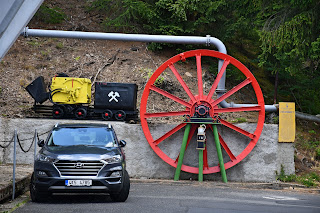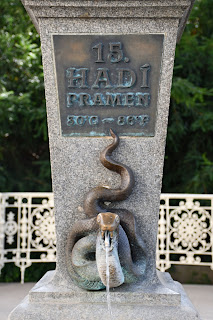A Day Trip to the Czech Far West
During my brief stay at home this summer – which I have informally dubbed my Eurosummer – my sister’s endless badgering led us to undertake exactly one domestic trip. Her desired destination was Loket Castle, a sight that lies about an hour and a half west of Prague. Situated on a peninsula within the bend of the Ohře River, Loket can only be approached by a series of narrow winding paths that lead to the centrally located Masaryk Square. Scarcity means that parking is limited to two hours, so we had to strategically plan lunch around feeding cash into the parking meter.
The interior of Loket
Castle is relatively standard for a Central European castle: there are a few
decorated halls, a lookout tower, and of course a torture chamber. As many
other places in Western Bohemia, the castle is associated with Johann Wolfgang
Goethe, who even contributed a few items to its mineral collection. The one
thing that sets Loket apart from other Czech castles is that it houses a
fifteen-kilogramme meteorite fragment, which was documented as early as the
seventeenth century. Back then, it weighed over a hundred kilogrammes, but it
was cut up in the seventeenth century and its fragments were sent to museums
around Europe.
After lunch, we drove
across the river and made a quick climb to a lookout over the town. The sun had
come out by then and the castle, bathed in golden light, stood proudly at the
highest point of the city. We then began our drive again, our next destination
being Jáchymov.
With its mining
cultural landscape inscribed on the UNESCO list of world heritage, Jáchymov is
in equal parts interesting, historically significant, and bizarre. Before
parking our car at Tunnel Number 1, we drove past the mine Svornost, the oldest
European mine still in operation. Opened in 1525, Svornost was used for
centuries to excavate silver, but in 1853 it became the first uranium mine in
the world; in fact, it was material from Jáchymov in which the Curies
first discovered polonium and radium. Svornost also supplies the world’s first
radon spa with radon-rich water.
We did not tour
Svornost or Tunnel Number 1. From what we could tell, Svornost is not open to
visitors, while Tunnel Number 1 operates on a rigid and somewhat inconvenient
hourly schedule. We did, however, see the outsides of both mines, accidentally
trespassing our way to the very opening of the Tunnel Number 1 opening. The
mine there was predominantly used to mine silver and, in later years, uranium. Indeed,
the whole town of Jáchymov is known for its silver and its short-lived
silver mint, the quality of which ensured the fame of the taler, a coin whose
name would come to be adopted by numerous countries including the United
States.
We ended our trip with
a brief visit to Karlovy Vary, a spa town of which I have already written on
this blog. Climbing down the hill to Park Colonnade, we walked along the
promenade to reach Mill Colonnade before turning back again. We got home around
dinnertime.































Comments
Post a Comment